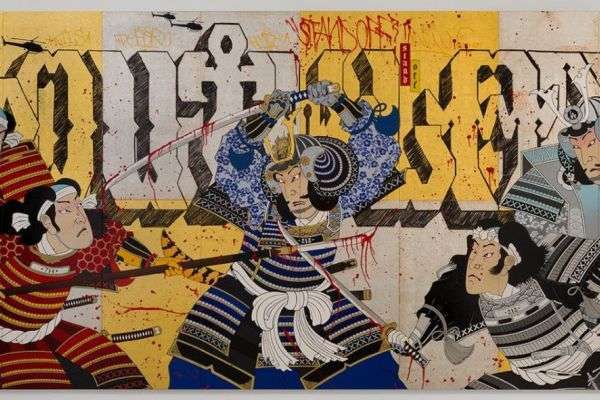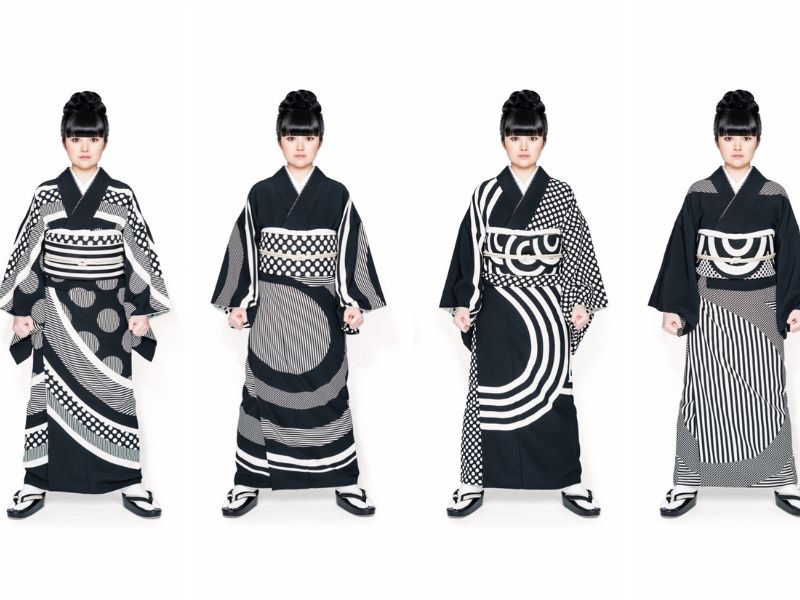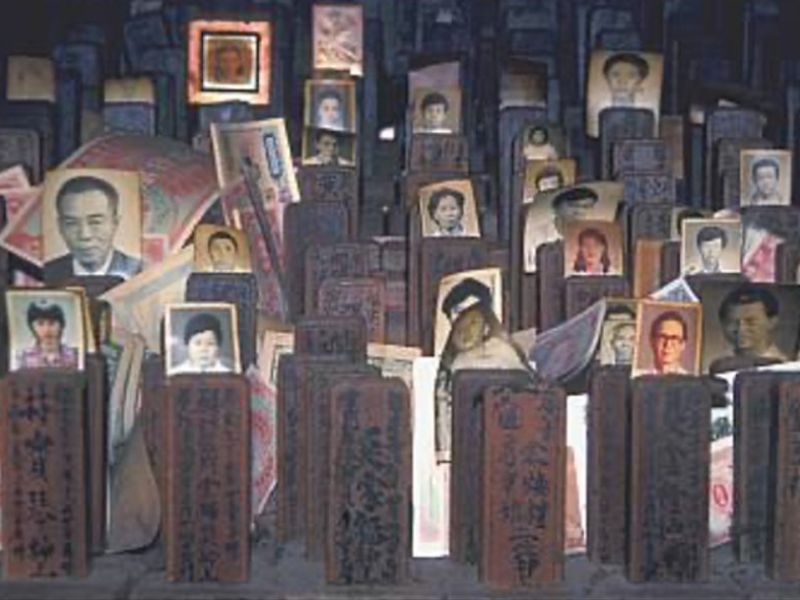
- This event has passed.

Gajin Fujita, Southland standoff, (cropped) 2013, AGNSW
This series of 6 lectures will focus on the manner in which the body was/can be decorated. This includes, but is not restricted to: dress and undress, accessories, body modification such as make-up (e.g. war paint), tattoos, scarification, hairstyling etc within the broader Asian region.
Monday 7th March 2022
Introduction and Dedicated Followers of Fashion: Indonesian Headhunters
Dr Marianne Hulsbosch
This Lecture Series on “The Decorated Body” will be introduced by Marianne.
Her presentation will examine headhunting as a ritualised act marking a man’s transition into adulthood. A man believed that the life force of his enemies could make him stronger. Most of this life force was located inside the human head, thus by acquiring the head of an enemy, continuity of clan and fertility of plants and animals was secured. This presentation considers the identity creation of the headhunter through sartorial means and how some of his accoutrements still take powerful positions in today’s society.
Dr Marianne Hulsbosch lectured for many years at the University of Sydney. She has extensive experience in lecturing in visual arts, design and textiles education at national and international levels. For her PhD in Creative Arts Marianne explored dress and identity construction in a colonial context. Marianne’ selected publications are: Pointy Shoes and Pith Helmets (2014), Leiden: Brill; Rites of Passage and Rituals in Indonesia; Cross-Dressing in Indonesia; Colonial Influence on the Sarong in Java In J. B. Eicher (Ed.), The Berg Encyclopaedia of World Dress and Fashion. (2010) (Vol. 4), Oxford: Berg Fashion Library Ltd. and Asian Material Culture (2009), Amsterdam: Amsterdam University Press.
Her current research interest is in visual culture, and she continues to play with textile materials, processes and contextual sites. She is the owner of SoulStitchingStudio Sydney where she conducts textile workshops to raise funds for NSW Women’s Community Shelters.
Monday 4th April 2022
Dressed to Kill: The Dandy in Samurai Armour
Dr Toby Slade
Samurai armour is some of the most beautiful and evocative military equipment ever produced, but throughout the long peaceful isolation period (1639-1853) its actual fighting practicality became less important and its social symbolism and capacity for aesthetic expression more so. It is a popular misconception that Japan abandoned firearms and returned entirely to swords and more traditional forms of military engagement in the Edo period but the revivalist movement in Japanese armour of this time was less about preparation for actual violence than a crisis of masculinity, social class, and national identity. This talk will consider whether it can even be read as a form of dandyism, with possible parallels to Baudelaire’s Paris and a sign of ascendant modernity.
Dr Toby Slade is associate professor of fashion history and the Director of Higher Degrees by Research in the Faculty of Design, Architecture and Building at the University of Technology Sydney. Toby has returned to Australia after more than 16 years at the University of Tokyo in Japan. He is the author of two books: Japanese Fashion: A Cultural History (Berg, 2009), the first English-language book to explore the entire historical sweep of fashion and clothing in Japan and Introducing Japanese Popular Culture (Routledge, 2018), which looks at fashion as a central component of popular culture.
Monday 2nd May 2022
The Stylist Regents: Refashioning Thai Female Sartorial Styles by Queen Saovabha Phongsri and Queen Sirikit.
Professor Pattaratorn Chirapravati
Clothing and politics may not seem to have much in common, but when utilized together they can become an important tool for reinventing national identity. The talk focuses on two female regents, Queen Saovabha Phongsri and Queen Sirikit of Chakri Dynasty in Thailand. Traditionally in Thailand, a high-ranking male royal member would be appointed by the king as a regent during a period of the king’s absence. However, Queen Saovabha Phongsri, a queen of King Chulalongkorn, became the first female regent for seven months during the time that the king, also known as Rama V, visited Europe in 1907. She was referred to as the “Queen Regent.” King Chulalongkorn ruled Siam between 1868 and 1910. The second female regent was Queen Sirikit in 1956, who was the queen of King Adulyadej, also known as Rama IX. He ruled Thailand from 1946 to 2016.
Professor Pattaratorn Chirapravati is an art historian who specializes in Buddhist art and Southeast Asian art visual cultures. She received her Ph.D. in Southeast Asian Art history and Southeast Asian Studies at Cornell University USA. She has published extensively on ancient Buddhist art (e.g., Votive Tablets in Thailand: Origin, Styles, and Uses (Oxford University Press, 2007) and Divination Au Royaume De Siam: Le corps, la guerre, le destine (Presses Universitaires de France, 2011). She co-curated two major art exhibitions at the Asian Art Museum of San Francisco entitled The Kingdom of Siam: Art from Central Thailand (1530–1800) and Emerald Cities: Arts of Siam and Burma (1775–1950). She is a faculty member in the Art Department and former Director and Vice Director of the Asian Studies Program at California State University, Sacramento. She is also former Head of Studies, Division of Arts and Humanities at Yale-NUS College (Singapore).
Monday 6th June 2022
Same but Different: Changing Hybrid Fashions in 19th- and Early 20th-Century Singapore
Peter Lee
Singapore might be a relatively new metropolis, but it inherited a freewheeling, volatile and diverse Southeast Asian legacy of hybrid port city culture that was several centuries old. Singapore instantly became a melting pot of people, goods and ideas, once it was founded as a colonial settlement in 1819. With no single cultural arbiter, and away from motherlands, its residents began to dress and shop as they pleased, sourcing from an array of available global goods perhaps wider than anywhere else in the world. Singapore residents were also able to combine ensembles of textiles and garments from across the globe in their own individual way, and often used them in completely different contexts from where they originated. These inconsistent and individual styles raise questions about the idea of traditional dress in Asia, and elucidate how Singapore was an early centre for an egalitarian attitude to fashion, that is fast becoming a norm in an intensely globalised and connected world.
Peter Lee is an independent researcher from Singapore. He is the Honorary Curator of the critically acclaimed Baba House, an historical house museum managed by the National University of Singapore. A prolific and meticulous researcher, Peter is the eminent writer of numerous books and articles on Peranakan material culture. In addition, he features as the host in the 2020 four-part series ‘Mark of Empire’ broadcast regionally by Channel News Asia (Singapore) and currently available on YouTube.
Monday 1st August 2022
From Printed Page to Porcelain and Beyond: Eurasian Fashion and the Decorative arts 1500-1800
Professor Peter McNeill
Fashion is transient, short lived and fragile. Yet it is also mutable and open to translations and transformations across media and genres. We will examine a series of artifacts that were fashions themselves: from Chinese export ceramics depicting fashions and fashionability, to reverse-painted portrait mirrors made for European traders. I argue for the inclusion of the decorative arts within wider accounts of Eurasian fashion culture as well as the importance of cross-cultural, comparative and transnational studies.
Distinguished Professor Peter McNeil FAHA is an award-winning design historian who works at University of Technology Sydney. His inter-disciplinary research examines fashion and wider design with a focus on identities from the eighteenth century to the present day. For a decade Professor of Fashion Studies at Stockholm University, more recently Academy of Finland (FiDIPro) Distinguished Professor, Aalto University. Publications include: ‘The Fashion History Reader: Global Perspectives’, 2010 (with G. Riello); ‘Fashion: Critical and Primary Sources, Renaissance to the Present Day’ (4 Vols. 2009); ‘‘Pretty Gentlemen’: Macaroni Men and the Eighteenth-century Fashion World’ (2018). He has a long term interest in Asian as well as Western art, having studied Australia’s first course on modern Asian art with Prof. John Clark at ANU.
Monday 5th September 2022
Women’s Socio-political Negotiation via Dress in Postwar Taiwan
Dr Lin Shih Ying
This presentation examines the interrelations between Taiwanese women´s bodies, dress, sociocultural position, and agency in the post-war era. It uncovers how particular forms of dress were used to create a dominating ideology during different periods in the history of Taiwan. It also reveals how changes in the political and economic situation, as well as the strategic bodily practice of Taiwanese women are reducing this power of dress.
Dr Lin Shih Ying is an assistant professor at Tainan University of Technology, Taiwan. Her doctoral project on bodily practices in post-war Taiwan was awarded in 2013 from Erasmus University Rotterdam, The Netherlands. Her research interests lie in the field of fashion, dress, body and gender. Lin recently published ‘Democracy in female fast-fashion: A case study in Taiwan’ (2021).
How to Book: Booking confirmation and payment in advance are essential. No refunds. Book via email to Chris Manning: bookings@taasa.org.au
How to Pay
1. By Direct Debit (“your name BODY” as reference)
BSB: 012 003 Account Number: 2185 28414
Account Name: The Asian Arts Society of Australia
2. By credit card on this website – see booking button on top right of this page


